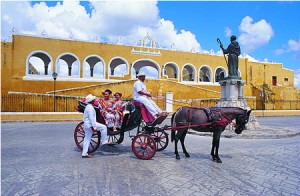 Izamal is a small colonial population in the state of Yucatan. It is named for the Mayan and means “dew of heaven”, it is located just 72 kilometers from Merida. It is known as the “city of three cultures”, since it combines features of its pre-Hispanic past, of the colonial period and modern times, also it has been called the “Yellow City” because most of their buildings are painted in this color. The city has been chosen as a “Magic Town”. In the city of Izamal, as in many towns of the Yucatan, the Mayan language is still spoken by most of its inhabitants.
Izamal is a small colonial population in the state of Yucatan. It is named for the Mayan and means “dew of heaven”, it is located just 72 kilometers from Merida. It is known as the “city of three cultures”, since it combines features of its pre-Hispanic past, of the colonial period and modern times, also it has been called the “Yellow City” because most of their buildings are painted in this color. The city has been chosen as a “Magic Town”. In the city of Izamal, as in many towns of the Yucatan, the Mayan language is still spoken by most of its inhabitants.
Izamal was one of the most important sites of Mayan civilization, a large settlement on the plains of the northern Yucatán Peninsula. The size of its buildings and network of pathways called ‘sacbes’ (white road built in the ancient Maya) are evidence of the religious, political and economic power that the city had over the vast territory of the Mayab. more…
Category: Izamal
|
Tags: City of three Cultures, dew of heaven, Izamal, Kinich Kakmó, Magic Town, Mayab, Mayan, Merida, Pap Hol Chack, Sacbes, San Antonio de Padua, TokHun Pik, Water of Life, Yellow City, Yucatan, Yucatan Peninsula |
Comments off
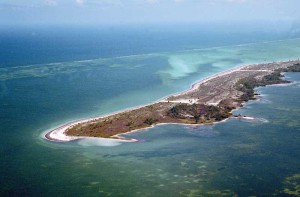 Holbox is a small and beautiful island located in the north of the state of Quintana Roo, its name come from the Mayan and means “black hole”. It has 43 km long, 2 km wide and about 34 km of white sandy beaches with countless shells in the coast. It is attached to the Yucatan Peninsula by a sand bar and several canals that join it to the sea and to the lagoon Yalahau. Holbox belongs to the municipality of Lázaro Cárdenas and is part also part of the biosphere reserve and protected area of Yum Balam which means Lord Jaguar, a reserve of 154,000 km2. more…
Holbox is a small and beautiful island located in the north of the state of Quintana Roo, its name come from the Mayan and means “black hole”. It has 43 km long, 2 km wide and about 34 km of white sandy beaches with countless shells in the coast. It is attached to the Yucatan Peninsula by a sand bar and several canals that join it to the sea and to the lagoon Yalahau. Holbox belongs to the municipality of Lázaro Cárdenas and is part also part of the biosphere reserve and protected area of Yum Balam which means Lord Jaguar, a reserve of 154,000 km2. more…
Category: General, Holbox
|
Tags: Caribbean Sea, Gulf of Mexico, Holbox, lagoon Yalahau, Lázaro Cárdenas, lobster pizza, Lord Jaguar, Port of Chiquilá, Quintana Roo, Yalahau, Yucatan, Yucatan Peninsula, Yum Balam |
Comments off
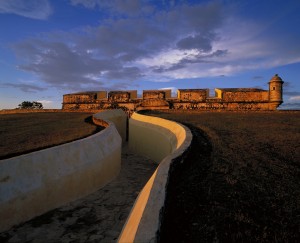 It is a historic fortified city on the shores of the Gulf of Mexico in the Yucatan Peninsula. It is renowned as one of the few walled cities in America and the only one in Mexico. One of the reasons it was declared Cultural Patrimony of Humanity by UNESCO in 1999 is the excellent condition of its historical heritage. The original Mayan settlement was called KaanPeech (In Mayan language: Kaan = snake, Peech = tick, which means: the place of snakes and ticks). When the Spanish arrived, they Hispanicized it to Campeche. After their arrival, the city became the largest port of colonial America, bringing an intense commercial traffic and subsequent construction of mansions and churches. However, the same wealth that allowed it to flourish attracted the attention of pirates whose expeditions not only led to endless stories, but that led to the lifting of impregnable fortifications that distinguish today’s place. more…
It is a historic fortified city on the shores of the Gulf of Mexico in the Yucatan Peninsula. It is renowned as one of the few walled cities in America and the only one in Mexico. One of the reasons it was declared Cultural Patrimony of Humanity by UNESCO in 1999 is the excellent condition of its historical heritage. The original Mayan settlement was called KaanPeech (In Mayan language: Kaan = snake, Peech = tick, which means: the place of snakes and ticks). When the Spanish arrived, they Hispanicized it to Campeche. After their arrival, the city became the largest port of colonial America, bringing an intense commercial traffic and subsequent construction of mansions and churches. However, the same wealth that allowed it to flourish attracted the attention of pirates whose expeditions not only led to endless stories, but that led to the lifting of impregnable fortifications that distinguish today’s place. more…
Category: Campeche
|
Tags: Archaeological Museum, Calakmul, Campeche, Carnival, Cultural Patrimony of Humanity, Earth Gate, Edzná, Fort San José El Alto, Gulf of Mexico, Hacienda Puerta Campeche, Haciendas, Juan Carnaval, KaanPeech, Mayan, New Spain, parade, Puerta de Tierra, Puerta del Mar, Sea Gate, UNESCO, Yucatan Peninsula |
Comments off
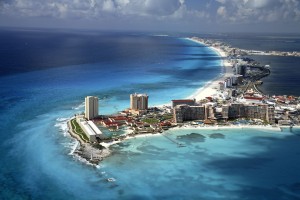 Cancun is the most important gateway to the Mayan world, where you people find beautiful and legendary archaeological cities and scenic and beautiful beaches. Cancun comes from the Mayan Kaan Kun, which means “nest of snakes”. Is located in the northeast of the Yucatan Peninsula and from its coast is possible to clearly see the Isla Mujeres.
Cancun is the most important gateway to the Mayan world, where you people find beautiful and legendary archaeological cities and scenic and beautiful beaches. Cancun comes from the Mayan Kaan Kun, which means “nest of snakes”. Is located in the northeast of the Yucatan Peninsula and from its coast is possible to clearly see the Isla Mujeres.
During the classical period and the post-classic Mesoamerican period, the Mayans had a business network from the Laguna de Términos to Honduras, for this activity they established shipping routes for travel touring the entire coast of the now state of Quintana Roo, for this, they made constructions by the sea for trade, as well as to monitor and assist navigation. Today people can find the vestiges of their greatness as the extraordinary strength of Tulum, Coba and City Kohunlich, among others. There are remains of many famous sites, but most of them unexplored. According to studies, the sites of “El Meco, Yamil Lu’um” and “The King” were points inhabited until the sixteenth century. more…
Category: Cancun
|
Tags: Activities in Cancun, Archaeological Museum of Cancun, Archaeological Zone, Ball Game, Calinda, Cancun, Cancun Castle, Cancun Hotel, Cancun Hotel Zone, Caribbean Sea, Caribbean Sea Cancun, Central Basin, Chichen Itza, City Kohunlich, Club Med, Coba, Del Amor, Dolphin Beach, East Coast, ecological park Kabha, El Farito, El Meco, El Niño, El Rey, English River, Francisco Hernandez de Cordova, historic museum, Honduras, Hotel Zone, Hotels Cancun, Isla Mujeres, Kaankún, Kukulkan, Lagoon, Laguna Bojórquez, Laguna de Términos, Mayan Empire, Mayan house, Mayan Kaan Kun, Mayan ports, Mayan world, Mediterranean, nest of snakes, Nichupte, Nizuc, North Basin, Observatory, Puerto Juarez, pyramid, Quintana Roo, Sacred Cenote, Scuba diving Cancun, South River, Temple of the Warriors, The Castle, The King, The Mirador, Tulum, turquoise lagoon, X-caret, Xel-Ha, Yamil Lu'um, Yucatan Peninsula |
Comments off
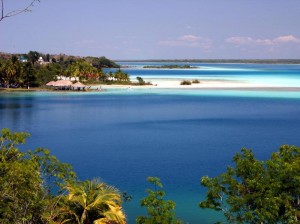 Bacalar is a town located 35 km from the city of Chetumal in the state of Quintana Roo and its name comes from the Mayan “bakhalal” which means place of reeds. This town is next to the famous Lagoon of Seven Colors, this town is a picturesque community for lovers of nature, adventure, history and cultural events, through which it acquired the level of Pueblo Mágico.
Bacalar is a town located 35 km from the city of Chetumal in the state of Quintana Roo and its name comes from the Mayan “bakhalal” which means place of reeds. This town is next to the famous Lagoon of Seven Colors, this town is a picturesque community for lovers of nature, adventure, history and cultural events, through which it acquired the level of Pueblo Mágico.
In pre-Hispanic times Bacalar was the most important town in Uaymil, one of the 16 provinces in which the Yucatan Peninsula was divided before the arrival of the Spanish conquerors. It was a prime commercial site as it was a transfer point for various goods brought from Central America, particularly from the region of Ulúa in Honduras. In 1531 were the first contacts with the Spanish conquerors in the area. more…
Category: Bacalar
|
Tags: Bacalar, bakhalal, Bay of Chetumal, Blue Cenote, Chetumal, Fort San Felipe, Honduras, Lagoon of Seven Colors, Laguna Bacalar, Museum of San Felipe de Bacalar, Pueblo Mágico, Quintana Roo, Uaymil, Ulúa, Yucatan Peninsula |
Comments off
 Izamal is a small colonial population in the state of Yucatan. It is named for the Mayan and means “dew of heaven”, it is located just 72 kilometers from Merida. It is known as the “city of three cultures”, since it combines features of its pre-Hispanic past, of the colonial period and modern times, also it has been called the “Yellow City” because most of their buildings are painted in this color. The city has been chosen as a “Magic Town”. In the city of Izamal, as in many towns of the Yucatan, the Mayan language is still spoken by most of its inhabitants.
Izamal is a small colonial population in the state of Yucatan. It is named for the Mayan and means “dew of heaven”, it is located just 72 kilometers from Merida. It is known as the “city of three cultures”, since it combines features of its pre-Hispanic past, of the colonial period and modern times, also it has been called the “Yellow City” because most of their buildings are painted in this color. The city has been chosen as a “Magic Town”. In the city of Izamal, as in many towns of the Yucatan, the Mayan language is still spoken by most of its inhabitants.



